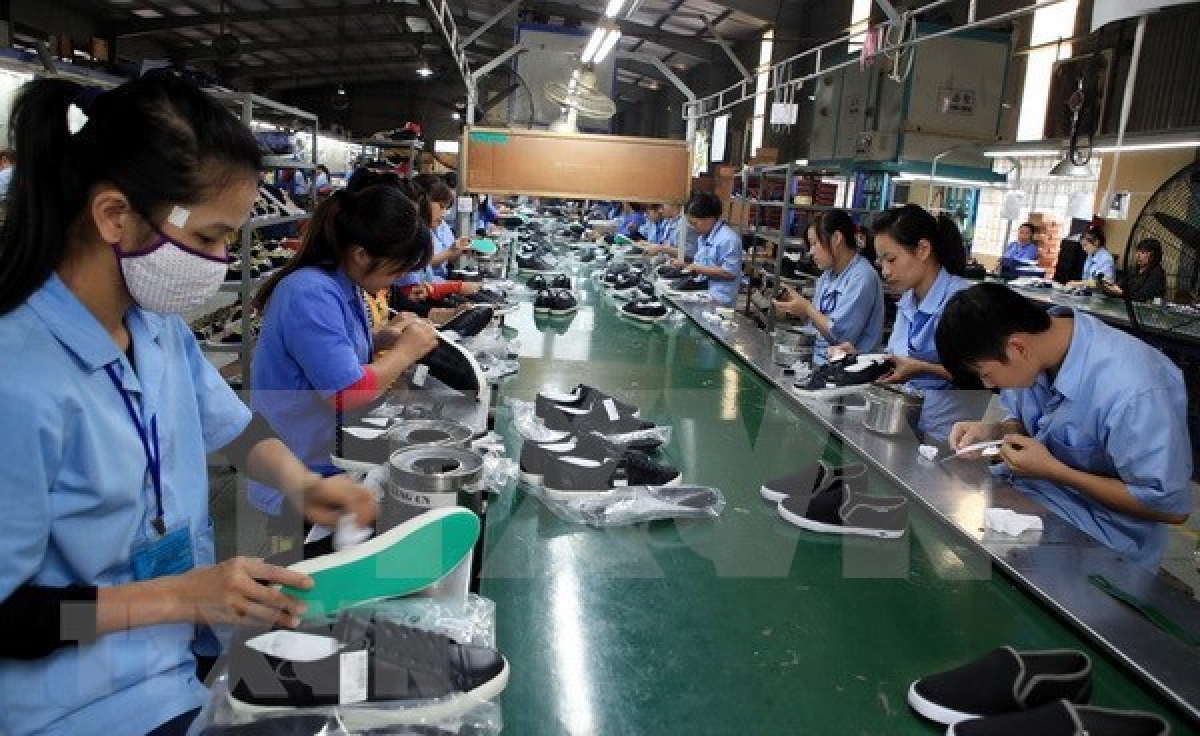Measures sought to help footwear industry get back on front foot
 |
According to Phan Thi Thanh Xuan, an expert from the project on promoting reform and enhancing connectivity of small and medium-sized enterprises funded by the US Agency for International Development (USAID), the industry had been negatively affected since the outbreak of the pandemic last year.
At that time, most enterprises merely had enough materials for production until the first week of March. From March onwards, the pandemic spread shut down the European and US markets where almost all stores were closed and sales fell freely.
Another problem is that prolonged pandemic has changed the trends, as well as the habits of consumers. More than 60% of consumers have cut down expenses on fashion products. About 65% of consumers have switched from fancy fashion to basic and durable fashion products, and 67% care about the quality of the working environment of manufacturing enterprises.
Enterprises have encountered difficulties as they have failed to find the market for their products and not revamped production in a timely manner to adapt to the new market changes.
Given this, Xuan suggested domestic enterprises increase their investment in automation, raise productivity to reduce costs, build closed production chains, and self-supply materials.
However, according to Nguyen Thi Xuan Thuy, head of the Department of Integration Strategy and Policy under the Institute of Industrial and Trade Policy and Strategy, out of 3,000 footwear producers, only 17 have designing activities, 400 process intermediate stages or produce auxiliary materials and accessories, and 20% of them use automation equipment.
Economic experts said it is time for Vietnam to look directly at the shortcomings of the domestic footwear industry. First of all, most enterprises produce under the cut, make, and trim (CMT) manufacturing. Because they export through foreign intermediaries, they have not yet built brands. Enterprises have also failed to grasp information about the trends of markets and customers, so they remain passive in production. Most enterprises only produce upon the orders given by partners.
As for the value chain, domestic enterprises are losing the balance between stages. Particularly, they focus more on the processing of footwear and bag products but less on designing, producing raw materials and auxiliary materials, and branding. The source of input materials is heavily dependent on imports, so it does not meet the requirements of rules of origin of new-generation free trade agreements. Just a few Vietnamese enterprises with big brands play a leading role in establishing the domestic supply chain.
Moreover, the fashion industry has yet to receive adequate attention and lacked linkage to form a chain. Regarding sustainability, the appraisal of manufacturing enterprises according to sustainability criteria has not been fully implemented. Activities related to traceability and transparency have not been methodically built and fully carried out. Authorities have not had specific criteria to monitor, evaluate, and use them as a foundation to develop policies to support the green and sustainable development of enterprises.
Quickly overcoming the above disadvantages will create conditions for enterprises to accelerate development.
Nguyen Duc Thuan, Chairman of the Vietnam Leather, Footwear, and Handbag Association (Lefaso), said that on average, the world produces 20 billion pairs of shoes annually, of which China accounts for 60%. Vietnam accounts for a modest percentage of about 5%.
However, in the context that orders from China are pouring heavily into Vietnam, the opportunity to expand the market share of the Vietnamese leather and footwear industry is great. From the end of last year up to now, long-term orders have returned steadily. Enterprises have actively made production plans until the end of this year.
Cao Quoc Hung, Deputy Minister of Industry and Trade, affirmed that the ministry had been promoting the implementation of groups of solutions for sustainable development of the footwear industry. Particularly, it will focus on developing raw materials and auxiliary materials for the textile and footwear industries in order to gradually meet the rules of origin of free trade agreements.
It will step by step support the establishment of the domestic textile, garment, and footwear value chains, focus on developing human resources to meet the needs of enterprises in the fields of management, designing, technology, market development, and research and development.
Besides, the Vietnamese textile and garment industry must go green, ensure international standards on environment, safety, labour, and sustainable development. This is also a necessary foundation for footwear enterprises to remove technical barriers and penetrate more deeply and broadly into the global market in the coming time.
Last year, the whole industry exported US$19.5 billion, down 11.5% compared to 2019.
Related News

“Greening” the textile, garment and footwear industry: Motivation from challenges
09:37 | 07/11/2024 Import-Export

The biggest problem for the footwear industry is rising costs
09:25 | 02/10/2024 Import-Export

Developing a raw material trading center to address bottlenecks in the textile and footwear industry
14:00 | 10/09/2024 Import-Export

Strictly handle violations of invoices in a timely manner to avoid budget losses
14:04 | 10/09/2024 Finance
Latest News

Processing-manufacturing accounts for over 64% of new FDI
15:09 | 07/11/2024 Import-Export

Foreign investment disbursement hits 19.58 bln USD in 10 months
15:08 | 07/11/2024 Import-Export

Truly comprehensive finance: supporting micro and small enterprises
09:36 | 07/11/2024 Import-Export

Challenges in reviving stalled projects
14:21 | 06/11/2024 Import-Export
More News

Ensuring fairness between domestically produced goods and imported goods
14:20 | 06/11/2024 Import-Export

Domestic exporters urged to shield against trade remedy threats
14:18 | 06/11/2024 Import-Export

Enterprises urged to further innovation, improve competitiveness to boost exports to Asia
14:16 | 06/11/2024 Import-Export

Increasing opportunities for exporting agricultural products to China by rail
15:31 | 05/11/2024 Import-Export

Monthly aquatic exports top 1 billion USD again after 2 years
15:00 | 05/11/2024 Import-Export

EU partners no longer 'lenient', Vietnam must adapt through ESG policies
09:02 | 05/11/2024 Import-Export

Changes in Canada's trade defense laws
09:00 | 05/11/2024 Import-Export

Import and export are expected to reach 800 billion USD
13:32 | 04/11/2024 Import-Export

Fresh coconuts quenching new overseas markets
13:29 | 04/11/2024 Import-Export
Your care

Processing-manufacturing accounts for over 64% of new FDI
15:09 | 07/11/2024 Import-Export

Foreign investment disbursement hits 19.58 bln USD in 10 months
15:08 | 07/11/2024 Import-Export

“Greening” the textile, garment and footwear industry: Motivation from challenges
09:37 | 07/11/2024 Import-Export

Truly comprehensive finance: supporting micro and small enterprises
09:36 | 07/11/2024 Import-Export

Challenges in reviving stalled projects
14:21 | 06/11/2024 Import-Export





